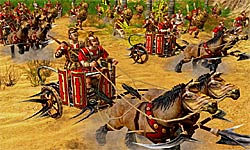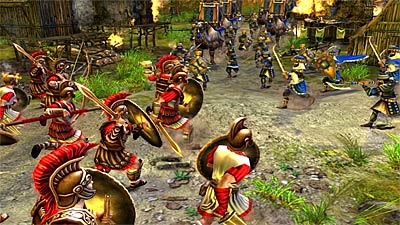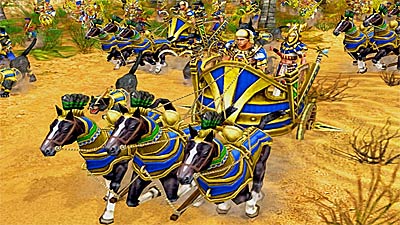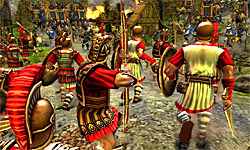This War Is Not So Great
These days it’s becoming harder and harder to discern one history-based ancient civilization real-time war strategy game from the next. Yes, there are a handful of superior titles out there, yet all too frequently the same old tired formula has been digested, retooled slightly, and then regurgitated back onto PCs ad nauseum with uninspiring results. Great War Nations: The Spartans is a shining example of this vicious cycle in PC gaming.

In developing The Spartans, it seems World Forge was hell-bent on making the game as close to last year’s Ancient Wars: Sparta as humanly possible. On comparison, the similarities between the two titles are so close they might as well have slapped a big old “Ancient Wars: Sparta 2” on the box and been done with it. It’s unclear whether the change in title was a strategic marketing move – Ancient Wars: Sparta was met with a lukewarm reception – or a genuine attempt to say; “this game may look the same, but it’s somehow different…honest.” Indeed, there are some improvements to be found in The Spartans, but it’s basically more of the same any way you look at it. Of course, let’s set Ancient Wars: Sparta aside for the moment.
Great War Nations: The Spartans gives you control over the Spartan or Macedonian armies in a series of violent and gory conflicts revolving around aspirations of power set in the Bronze Age. There’s a separate, seven-mission campaign for each of the two races that offers some variation in story and units. You can also play as the Egyptians or Persians in multiplayer or custom maps. Much of the story involves armies of burly, sweaty men flexing their manly muscles and thrashing on their adversaries to show everyone who’s shorts are bigger, but that’s not atypical in war is it? The gameplay is a little more elaborate than that; but success in each mission is basically a matter of gathering the needed resources, amassing a sizeable army, and stomping your opponents’ teeth into the ground with brute force. That said, The Spartans does put some interesting concepts in play that seem out of place (in a good way) in an otherwise generic RTS framework.

The game’s piecemeal approach to unit construction gives you a surprising level of control over how you’ll raise your army and stock each soldier. You’ll start with a basic warrior template that can be equipped with specific weapons and shields, depending on what level of forging you’ve researched or the kinds of items scavenged from battle. Once you’ve created a few different hand-picked presets, you can simply click on the building and select them for training at any time. Slaves can be sent out to gather weapons from fallen foes, which allows you to stock your armies faster and at a cheaper price, but the collection process is tedious and basically unnecessary beyond the early portion of a mission.

Units constructed in the barracks will specialize in melee attacks, while units from the training camp will primarily use missile weapons. You can assign a secondary attack, but each unit will do more damage with its primary combat method. The downside of dual attack units is you’ll have to manually switch between melee or missile attacks on the field. Mounted units can also be created; you’ll have to create horses and then select a separate warrior unit to jump on. If a horse becomes riderless, assuming it survives the battle, you can have another unit jump on. Siege weapons, healers, and other special units round out the basic warrior variations that’ll make up the bulk of your force. The ability to construct traps for opponents is another cool feature that will factor into your strategy.

The level of freedom players are afforded in creating their massive legions is impressive, but how their armies perform on the battlefield is quite the opposite. Horrendous pathfinding will have your forces marching in completely unexpected directions to get from point A to B, and their occasionally moronic A.I. severely hampers their effectiveness in any dire situation. Even the most structured battle plans will quickly fall apart in the midst of a bloody clash. There’s nothing like having your troops randomly break off from the main force to pursue passing foes in the distance only to run right by the ones that are causing immediate harm. Other times they’ll simply just frantically run back and forth not attacking much of anything. Attempting to circumvent heavily fortified enemy encampments, particularly in earlier levels when powerful siege equipment is not readily available, is also extremely frustrating. It’s a serious blow, considering the game is so squarely rooted in raw combat. Sea combat is even more atrocious; it’s best avoided altogether when not required for completion of a mission.
Resource management is pretty standard; you’ll have to gather gold, wood, and food – all of which are essentially in near-endless supply – to fuel expansion of your armies. In a subtle twist, units will slowly lose health due to starvation when food is scarce. This isn’t an issue most of the time, and the health of wounded allies will slowly regenerate when there’s food aplenty. Food and wood harvesting works well enough, but a production-crippling issue with the gold mine arose several times in different missions that ground the Spartan war machine to a halt. There are times when all your slaves will simply stop mining gold and congregate outside the mine for no apparent reason. Since the infinite gold situation guarantees you won’t be paying very close attention to the gold mine for most of the game, the only indication something is amiss comes when you actually almost run out of gold completely. This can pose a serious problem when trying to rapidly re-stock your army before or after battle. Getting gold production to resume is a matter of manually selecting individual slaves and moving them out of the group before re-assigning them to the mine one at a time. It’s unnecessary and tedious.
Despite its gameplay issues, The Spartans is a slick-looking title. The overall level of polish that went into creating the environments, buildings, and units is clearly apparent, and the many small details add up. From the chaos on the battlefield to the animations of warriors training and researching in the buildings, the graphics are strong. You can zoom in closely to view the bloodshed of battle if you choose, but the camera angles are a bit awkward. Also, a little too much of the visual real estate is taken up with menus and sidebars. Otherwise, the game excels in the visual department.
The Spartans has some of the makings of a winner, but it suffers from just a few too many of the familiar old pitfalls in the gameplay department – and some new ones. If the same level of polish afforded to the visual areas of the game was put into the play mechanics, World Forge could have had a strong RTS game on their hands. Instead they delivered a mediocre experience with a few good ideas that’s ultimately bogged down by a mess of technical issues.
RATING OUT OF 5 RATING DESCRIPTION 4.5 Graphics
It’s a good looking game. The attention to detail is noteworthy. 2.2 Control
Touchy camera controls can be frustrating when things get chaotic. Unit pathfinding is extremely poor and your armies are not nearly responsive enough in battle. 3.5 Music / Sound FX / Voice Acting
Decent audio tracks and reasonable macho voice acting suits the game’s style. 2.8 Play Value
Some aspects of the game are quite enjoyable, but things fall apart quickly when the technical issues begin to pop-up. 2.9 Overall Rating – Average
Not an average. See Rating legend above for a final score breakdown.
Game Features:
